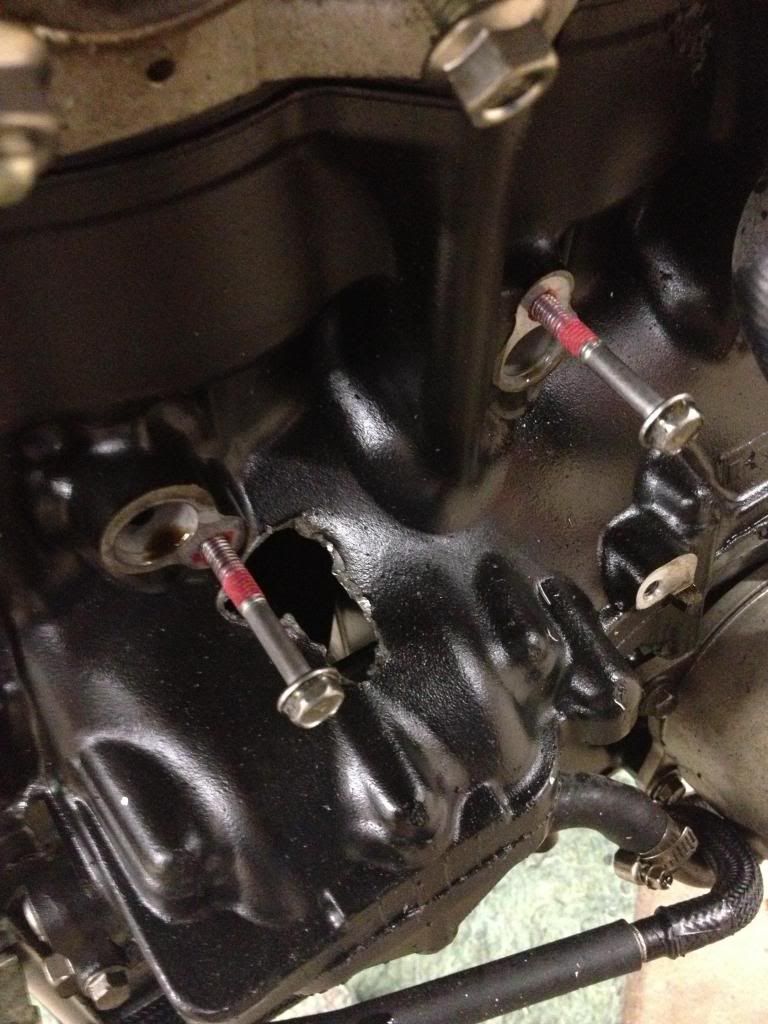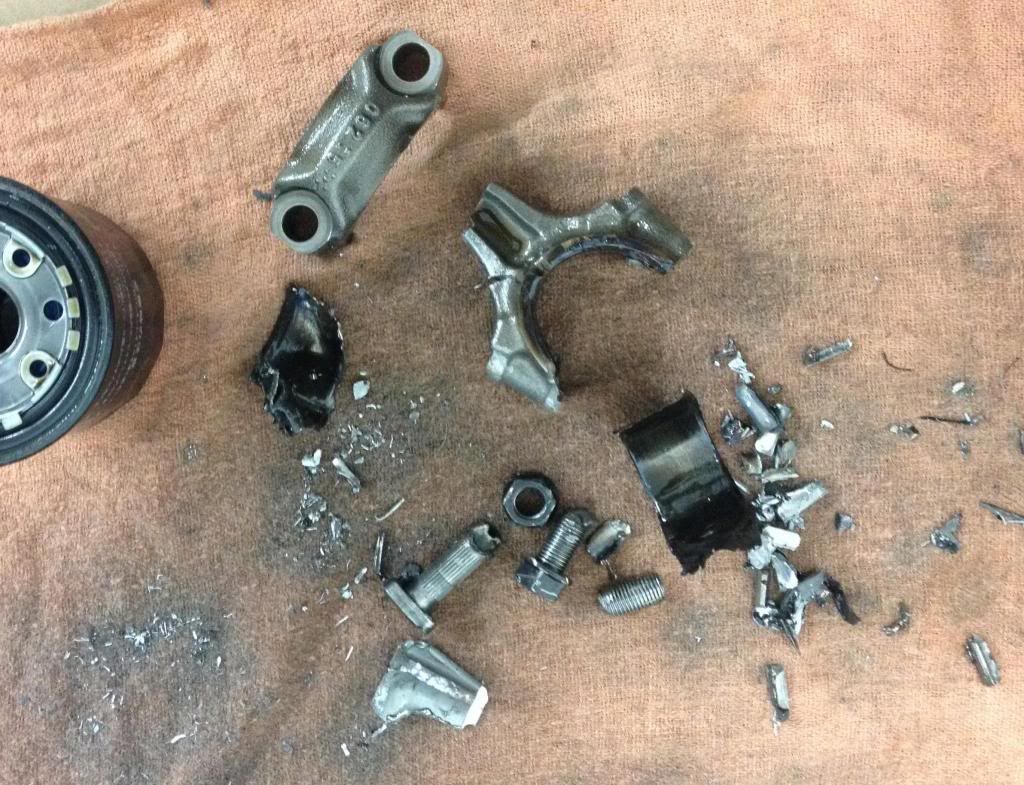Article Rob linked was a good read.
Westech Discussion
Oil-related failures of ZX-11s
We have offered oil bypass systems since 1994, and have made these observations over the last five years. Initially our system added an external #8 line and fed oil directly to the #3 bearing. While this system worked, it was a little difficult for some owners to install. It required a little filing of the inside cases and fitting a single standtube between the oil pan and the crank assembly. The filing was a little messy and getting the standtube fitted properly could be trying. The external line was also a hassle to work around when changing the oil.
We spent a winter measuring the oil flow, pressure and volume, of a stock bike with stock pan etc., and the same bike with our external bypass system. The results? Flow of our external bypass oiling system was up 25% in volume to the big end at the same pressure level. We then worked through some different configurations and came up with an internal modification (to the 'J' tube, 'I' tube and oilpan) that increased the flow the exact same amount…25%. The internal 'bypass' (it actually isn't a bypass but that's how we refer to it) is easier to install and servicing the oil filter is the same as stock. We immediately offered this kit and guess what? Most everyone was skeptical and wanted the old 'proven kit'. Well, it's been a couple of years now and the new system is proving just as reliable as the external system. We do have several shops that insist on using the older system and we just smile and give them what they want. But I want to make it known right here, right now: both the internal and external bypass kits increase the flow the same amount. As far as the engine is concerned either kit does exactly the same thing…increase the quantity of oil available to the big end.
Now as to what causes these failures: we have studied dozens and dozens of pans (with their J and I tubes). Of the pans that came from engines that had lost the #3 rod all but two had some sort of obvious restriction compared to most of the others that came from non-blown up engines. Most of these restrictions weren't significant…although several had quite a large ball of brass in the area where the fittings are joined to the tubes. It now appears that if the oiling system is at all marginal, for whatever reason or reasons this added restriction is enough to allow for the oil starvation and ultimately the rod failure. Quite a few shops have their own special cure, i.e. (listed from most used to least used 'cures'), switch to the most expensive synthetic oil, add every oil additive that they can find, increase the oil pressure, block off/remove the balancer shaft assembly, add a bypass system. Oil related failures generally show up in the #3 bearing.
The only other consistent oil related failure shows up on the cam. If you've had an oil related cam failure you can rest assured that you're bottom end is getting plenty of oil. To put it another way, if the oil supply to your bottom end is impaired the #3 bearing is going to fail much quicker than a camshaft, so if your camshaft failed the odds are excellent that your bottom end is okay. We've talked with hundreds of ZX11 owners that have tens of thousands of miles on their bikes. We have to believe that since there are so many totally stock engines with many thousands of miles on them, ridden by riders who are totally abusive to their equipment, that if the engine is manufactured at or near its proposed design tolerances the stock oiling system is adequate. When the tolerances are off a little (remember that at some point all it takes is one more straw to break the camel's back) the #3 rod is very susceptible to an oil related failure. The effect of increasing the oil pressure might be enough hedge to handle the potential for oil starvation, but by increasing the oil pressure the engine will be using more power to turn the pump and that means less available horsepower to you. Eliminating the balancer shaft assembly will increase the initial volume of oil to the #3 bearing and the engine will rev quicker. If your crank isn't well balanced you'll notice an increased vibration level and in some extreme situations these vibration levels will cause a catastrophic engine failure.
It's not wise to eliminate the balancer shaft unless the crank assembly can be balanced by a professional shop. Falacon has been doing it for years and they know their business. Synthetic oil / filter changes at least every 2,000 miles will also give your engine a fighting chance.
So many choices, but what to do? If your engine is a candidate for an oil bypass system then an oil bypass system is the most reasonable and economical solution. How can you tell? Well, if your bike was manufactured after 4/97 you probably don't need the system. To date we haven't heard from anyone with a mid '97 or later bike that has lost #3. UPDATE-SEE BELOW! If you are the original owner, have at least a few (2 to 3) thousand miles on the engine and aren't planning to change your riding habits, drop the oil pan. Pop off the lower #3 bearing cap and inspect it. If the bearing appears new without any wear marks you can breathe a big sigh of relief. Bolt it back together, retorque the bearing cap and keep taking care of the engine. If there is just a tiny indentation on the bottom of the bearing surface, but no scuffing you would be wise to at least replace that bearing and install an oil by-pass kit. If the bearing appears damaged, you have problems and you had better fix them now before your engine blows up.
This table compares modification options:
Modification
Effective change
Pros
Cons
Oil by-pass system
internal
Increases oil flow to crank assembly
Can overcome build quality restrictions
Costs money.
Oil by-pass system
external
Increases oil flow to crank assembly
Can overcome build quality restrictions
Costs money.
More difficult to install than internal. Oil changes a little messy.
Increase oil pressure
Increases pressure throughout the system
Oil flows more quickly to all orifices, surfaces
More oil pressure costs engine HP. May increase aeration, lessening the films lubricating qualities
Remove balance shaft assembly
Increases initial flow to lower end
If done properly will increase engine response and probably increase oil flow enough to handle most #3 oil flow problems.
If crankshaft isn't very close to target balance values the engine may vibrate itself apart.
Synthetic oil
Cooler running, better lubricating qualities.
Is a good way to add durability to an engine.
If used as a Band-Aid for a compromised oiling system may or may not give enough of a safety margin.
Oil additives
Made to enhance oil qualities
In certain situations can add that little extra protection that is needed.
Generally doesn't do much, if anything to enhance top quality synthetic oil.
If you're on a tight budget and can't afford an oil bypass system you can improve your oiling system a little by carefully honing the 'I' tubes internal fittings. Make sure that after honing you use a round deburring tool to radius the inside joint areas of the tube and fitting. Be careful not to remove too much material or you will have to rebraize the fittings Although this isn't the major restriction in the system, the removal of this material will allow the oil to flow a little move smoothly. This in turn reduces the potential for aeration.
The 'J' tube presents the biggest restriction. At Westech we have a special fitting manufactured and tig welded in a jig to the customer's 'J' tube; the pan is then honed to accept this fitting and we hone/debur the 'I' tube. We offer this modification service for $274.95. Our general turn-around time is 5 days but if you are in dire need we can and will process the pan within 48 hours.
Here are some useful contacts and links:
Falicon Performance 813-797-2468 - Crankshaft rebuilding and repairing
Oil Ratings: Motorcycle Consumer News: http://www.mcnews.com - You can read the original tests, February, 1994, updated August, 1998.
We hope this information has been helpful to you.
UPDATE, July 2001
Over the past year we have been seeing an alarming amount of 1997 and later ZX11s with oil related engine failures. Our educated guess as to why these failures are starting to show up has to do with engine wear. As an engine begins to wear, all clearances increase. Apparently the ZX11 oiling system (even with Kawasaki's attempts to 'help' the situation) is marginal, period. So....although we aren't looking to scare owners of late models....it appears as if the oil by pass mod should be done to all ZX11s regardless of manufacturing date.
UPDATE, April 2002
Due to a lack of demand, we are no longer offering the external by-pass. The internal by-pass offers the same advantage as the external by-pass and is easier to install and offers a stock external appearance when installed.












